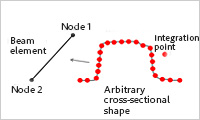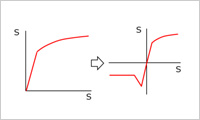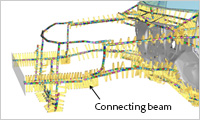J-SimRapid Functions
J-SimRapid is a modelling tool for creating a reduction model with beam elements that supports large deformation and crash simulation.
Dedicated viewers and GUI allow you to interactively create beam models from Ansys LS-DYNA shell models.
Feature Highlights
- Creating a Reduction Model for Large deformation and crash
Reduction Model Creation with Beam Elements
J-SimRapid creates a reduction model using arbitrarily shaped cross section Hughes-Liu beam elements from an Ansys LS-DYNA shell model. Beam modelling created on a part-by-part basis are joined via spot welding using the "Connected beam method (patent-pending)" developed by JSOL. In addition, the material model set for shell elements in the existing model is converted to a "beam material model considering buckling deformation (patent-pending)".
Creating Hughes-Liu beam elements for an Arbitrary Cross Section
Model with the Hughes-Liu beam element, which is Ansys LS-DYNA's default beam element. In addition, this method uses the Arbitrary Cross-Section Shape function to arrange integration points along the cross-sectional shape. This reproduces the complex cross-sectional shapes of the shell element model with the beam element model.

Creating Material Models for Beam Models
When compressing parts modeled with shell elements, the cross-sectional shape buckles, reducing the response load. On the other hand, beam elements cannot reproduce buckling deformation because their cross-sectional form does not deform. We have developed a user subroutine for beam elements that reproduces behavior of response loading reduction due to buckling deformation using a material model.

Generating a Connection Beam
In this modeling method, components are modeled by beam elements and joined by a connection beam through a spotweld. The Connection Beam method is used not only for joining beam models together, but also for joining beam models to shell models.


